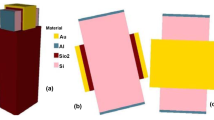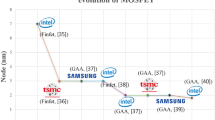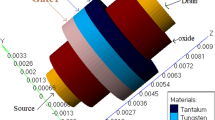Abstract
Self-heating effects (SHE) in silicon-on-insulator (SOI) based tri-gate junctionless field effect transistor (TG-JLFET) due to low thermal conductivity of buried oxide (SiO2) is studied in this paper. Self-heating results in degradation of drain current due to reduced mobility and also negative differential conductance (NDC) is seen in saturation region. This paper shows that substrate bias voltage can dynamically reduce self-heating and NDC in TG-JLFETs. The analysis is carried out by three-dimensional TCAD simulation using Sentaurus device simulator.
Similar content being viewed by others
Availability of data and material
The authors declare that all data and materials as well as software application support their published claims and comply with field standards.
References
Monga U, Aghassi J, Siprak D, Sedlmeir J, Hanke C, Kubrak V, Heinrich R, Fjeldly TA (2011) Impact of self-heating in soi finfets on analog circuits and interdie variability. IEEE Electron DevLett 32(3):249–251
Zhang G, Gu Y, Li J, Tao H (2015) An improved model of self-heating effects for ultrathin body soi nmosfets based on phonon scattering analysis. IEEE Electron Dev Lett 36(6):534–536
Triantopoulos K, Cassé M, Barraud S, Haendler S, Vincent E, Vinet M, Gaillard F, Ghibaudo G (2019) Self-heating effect in fdsoi transistors down to cryogenic operation at 4.2 k. IEEE Trans Electron Dev 66(8):3498–3505
Goel AK, Tan TH (2006) High-temperature and self-heating effects in fully depleted soi mosfets. Microelectron J 37(9):963–975
Mariniello G, Pavanello MA (2014) A simulation study of self-heating effect on junctionless nanowire transistors. In: 2014 29th Symposium on Microelectronics Technology and Devices (SBMicro), pp 1–4
Mariniello G, Pavanello MA (2015) Simulation comparison of self-heating effects in junctionless nanowire transistors and finFET devices. The Electrochemical Society
Kumar A, Gupta A, Sanjeev R (2018) Reduction of self-heating effect using selective buried oxide (selbox) charge plasma based junctionless transistor. Aeu-Int J Electron Commun 95:162– 169
Bergamaschi FE, Mariniello G, Barraud S, Pavanello MA (2018) Experimental analysis of self-heating effects using the pulsed iv method in junctionless nanowire transistors. In: 2018 33rd Symposium on microelectronics technology and devices (SBMicro), pp 1–4
Singh B, Gola D, Singh K, Goel E, Kumar S, Jit S (2016) Analytical modeling of channel potential and threshold voltage of double-gate junctionless fets with a vertical gaussian-like doping profile. IEEE Trans Electron Dev 63(6):2299–2305
Talukdar J, Rawat G, Choudhuri B, Singh K, Mummaneni K (2020) Device physics based analytical modeling for electrical characteristics of single gate extended source tunnel fet (sg-estfet). Superlattice Microst 148:106725
Talukdar J, Rawat G, Singh K, Mummaneni K (2020) Low frequency noise analysis of single gate extended source tunnel fet. Silicon
Colinge JP, Lee CW, Afzalian A, Akhavan ND, Yan R, Ferain I, Razavi P, O’Neill B, Blake A, White M, Kelleher AM, Mccarthy B, Murphy R (2010) Nanowire transistors without junctions. Nat Nanotechnol 5:225–229 02
Lee CW, Afzalian A, Akhavan ND, Yan R, Ferain I, Colinge JP (2009) Junctionless multigate field-effect transistor. Appl Phys Lett 94(5):053511
Gola D, Singh B, Tiwari PK (2018) Subthreshold modeling of tri-gate junctionless transistors with variable channel edges and substrate bias effects. IEEE Trans Electron Dev 65(5):1663– 1671
Gola D, Singh B, Tiwari PK (2017) A threshold voltage model of tri-gate junctionless field-effect transistors including substrate bias effects. IEEE Trans Electron Dev 64(9):3534–3540
Gola D, Singh B, Singh J, Jit S, Tiwari PK (2019) Static and quasi-static drain current modeling of tri-gate junctionless transistor with substrate bias-induced effects. IEEE Trans Electron Dev 66 (7):2876–2883
Sentaurus (2016) Device simulation software. Version N-2017.09, Synopsys, Mountain View, CA, USA,
Funding
The authors declare that Deepti Gola has received research 179 support from Indian Institute of Technology Patna. Further, 180 authors have no other relevant funding or financial support 181 to disclose in relevance to the work shown in this paper.
Author information
Authors and Affiliations
Contributions
All authors contributed to the study conception and conceptualization. Material preparation, TCAD simulation and analysis were performed by Deepti Gola. Formal analysis and investigation of the simulated results were done by Yograj Singh Duksh and Pramod Kumar Tiwari. The first draft of the manuscript was written by Deepti Gola and edited by Balraj Singh and Pramod Kumar Tiwari. Moreover, all the authors commented on previous versions of the manuscript and the final manuscript was read and approved by all the authors. Finally, the complete work was carried under the supervision of Pramod Kumar Tiwari.
Corresponding author
Ethics declarations
Declarations
The authors declare that Deepti Gola has received research support from Indian Institute of Technology Patna. Moreover, Pramod Kumar Tiwari is affiliated to Indian Institute of Technology Patna. Further, Yograj Singh Duksh and Balraj Singh are affiliated to M.J.P. Rohilkhand University Bareilly and G.B.Pant Institute of Engineering and Technology Pauri respectively. Further, authors have no other relevant financial/non-financial interests or personal relationships that could have appeared to influence the work reported in this paper to disclose.
Moreover, the research work submitted in this paper has no involvement of human participants and animals. Therefore, no informed consent is required to publish the work of this paper.
Consent for Publication
All the authors declare their consent to transfer the publication rights to the journal in which this manuscript is submitted.
Consent to Participate
The authors declare that the research work submitted in this paper has no involvement of human participants and animals. Therefore, no consent to participate is required for publishing the work of this paper.
Conflict of Interests
The authors declare that Deepti Gola has received research support from Indian Institute of Technology Patna. Moreover, Pramod Kumar Tiwari is affiliated to Indian Institute of Technology Patna. Further, Yograj Singh Duksh and Balraj Singh are affiliated to M.J.P. Rohilkhand University Bareilly and G.B.Pant Institute of Engineering and Technology Pauri respectively. Further, authors have no other relevant financial/non-financial interests or personal relationships that could have appeared to influence the work reported in this paper to disclose
Additional information
Publisher’s Note
Springer Nature remains neutral with regard to jurisdictional claims in published maps and institutional affiliations.
Rights and permissions
About this article
Cite this article
Gola, D., Duksh, Y.S., Singh, B. et al. Self-heating and Negative Differential Conductance Improvement by Substrate Bias Voltage in Tri-gate Junctionless Transistor. Silicon 14, 2219–2224 (2022). https://doi.org/10.1007/s12633-021-01019-1
Received:
Accepted:
Published:
Issue Date:
DOI: https://doi.org/10.1007/s12633-021-01019-1




